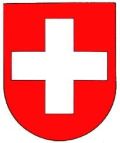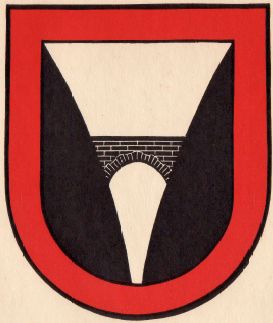Engi: Difference between revisions
Jump to navigation
Jump to search
Knorrepoes (talk | contribs) m (Text replacement - "/Arms of " to "/Arms (crest) of ") |
Knorrepoes (talk | contribs) m (Text replacement - "{{media}}" to " {{ch1}} {{media1}}") |
||
| Line 15: | Line 15: | ||
The silver point in the arms is a chanting symbol. The village is in a vally, with a very narrow (Eng) entrance, which is symbolised by the point. The bridge is the local bridge over the Sernft river. The black mountains symbolise the local mountains, but also the mining of black slate in the village. The mining company was taken over in 1844 by the Canton, which is symbolised by the red bordure; by the red colour all three colours of the arms of the canton are represented in the arms. | The silver point in the arms is a chanting symbol. The village is in a vally, with a very narrow (Eng) entrance, which is symbolised by the point. The bridge is the local bridge over the Sernft river. The black mountains symbolise the local mountains, but also the mining of black slate in the village. The mining company was taken over in 1844 by the Canton, which is symbolised by the red bordure; by the red colour all three colours of the arms of the canton are represented in the arms. | ||
{{ | |||
{{ch1}} | |||
{{media1}} | |||
[[Literature]] : Tschudi-Schümperlin, 1941 | [[Literature]] : Tschudi-Schümperlin, 1941 | ||
Revision as of 06:51, 30 December 2022
Swiss heraldry portal
This page is part of the Swiss heraldry portal |
Heraldry of the World |
|
Swiss civic heraldry:
|
Other heraldry: |
ENGI
Canton : Glarus
Incorporated into : 2011 Glarus-Süd
Official blazon
Origin/meaning
The arms were officially adopted on May 21, 1941.
The silver point in the arms is a chanting symbol. The village is in a vally, with a very narrow (Eng) entrance, which is symbolised by the point. The bridge is the local bridge over the Sernft river. The black mountains symbolise the local mountains, but also the mining of black slate in the village. The mining company was taken over in 1844 by the Canton, which is symbolised by the red bordure; by the red colour all three colours of the arms of the canton are represented in the arms.
Literature : Tschudi-Schümperlin, 1941


